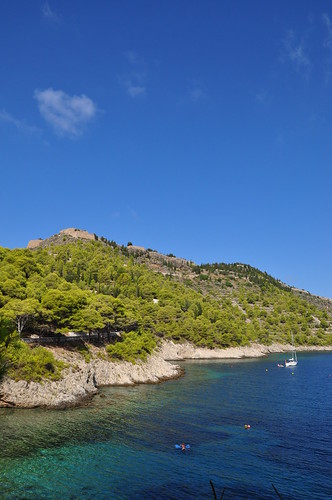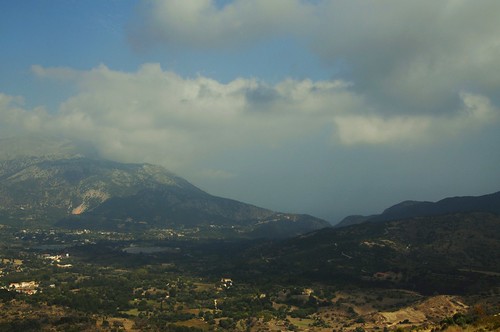
In the summer of 1953 there was a massive earthquake in Kefalonia, which I had heard/read about prior to coming here. I didn’t expect to see the effects of it still so clearly visible around the island.

This rock is about 50 metres offshore of a beach down the road from our apartment. On the lower right hand side of the rock you can see where the sea level was on this side of the island prior to the earthquake – it’s a good metre and a half lower now. If you were to walk/swim along the cliffside to the left of the frame, you would see what used to be sea caves exposed all along the rock face.

Turning left away from the rock. This is the municipal building that we have been using for Greek classes/pottery washing/artifact storage/the occasional movie night. Which leads me to mention my 21st birthday, which was last Monday. Uh, best birthday ever. The first half of the day I excavated the rest of the bone deposit, then I had a nap and watched the first part of Lord of the Rings with the group and ate cake and pizza. I seriously could not have asked for a better day.
Ehhh back to the earthquake! Poros wasn’t an established town until after 1953, when people from the destroyed mountain villages moved down to the sandier coastal areas where their homes were more likely to survive another earthquake. The ancient towns and cities of Kefalonia weren’t usually built on the coast, because the Ionian had a serious pirate problem well even into the 18th century.

This is a Venetian castle in Assos, on the other side of the island from Poros. Good for hiding from pirates. Pictures from the north side of the island (Myrtos, Assos and Fiscardo) are here. It's much more touristy than the Poros area, which results in the kind of stereotypical whitewashed and brightly painted buildings. Really, really brightly painted, and blindingly bright sky and water. I actually took down the saturation in some of the photos because they were looking a little too neon.

This is also Assos, which actually survived the earthquake better than the southern end of the island. There are a few abandoned, ruined houses in and around the villages by Poros but most didn’t even survive enough to become hollowed out ruins. Just rubble.
Hettie, who works for the municipality and has done a lot of the work to organized the field school, told us some stories about the earthquake. If you talk to someone from Kefalonia who was born before or around the earthquake, one of the first things they often tell foreigners is where they were when the earthquake happened. George, the man who owns the house next to our apartment and who graciously lets us use his washer, was stationed in Australia with the army at the time. After the earthquake something like two thirds of the island moved away. After World War II, the late 1940s Greek civil war and the earthquake, what else could you do? How many more times were you supposed to rebuild?

Makis, Hettie’s husband, was six months old in August 1953 and his family stayed on Kefalonia. Hettie told us that the main reason that the loss of life was less than it could have been was because the biggest earthquake happened very early in the morning in a hot month when most people were sleeping outside in their gardens rather than in their homes. Makis was the only one in his family who was still in his house and survived a wall falling on top of him. Another woman Hettie knows says her husband was standing underneath an olive tree when the earthquake hit. He reached up and grabbed onto a branch with both hands to keep from falling, and he was lifted off the ground as the tree turned a full 360 degrees in the ground. That was definitely something new I learned: I knew earthquakes can create up and down movement, and lateral movement, but some also cause sections of land to move in a circular fashion.

Our excavation site is on the slope of this acropolis, the ancient Pronnoi acropolis. Experiencing an earthquake while on site probably wouldn’t be nice, but to honest I worry more often about the effects of the rain on the artifacts and skeletons we’ve exposed. Yet again we had to leave two opened graves exposed over the weekend, a weekend where it (yet again) thundered and rained like hell.
The majority of the graves in the cemetery are 6th century pithoi burials. Pithoi (singular: pithos) are large, kind of almond shaped pots used for food storage. Some people have pithoi or replicas as planters in their gardens in front of their houses on the island, kind of like old barrels and cartwheels in western Canada. Since the burials are on the side of a hill, the ancient Pronnoi people would dig a wide, deep hole and line it with rocks and gravel to keep the burial from collapsing. The pithos would be broken up and rebuilt on its side in the gravel, with the corpse and grave goods placed inside it before the top of the pithos was rebuilt over them. Right now there is a slightly disturbed pithos being excavated – the skeleton is mostly exposed now. There is also another partial, non-pithos burial that was partially excavated last year. This year we had to move a section of wall that had been built over top of the head and torso of the skeleton and, believe me, the head definitely looks like the guy had a stone wall built on top of him.

I haven’t been working on either of the above burials, but I have been clearing out a bone deposit with Julie, the one person here who actually knows her bones (something I cannot claim quite yet). We thought it was just scattered bone from a disturbed burial until Julie found a pair of articulated feet at one end – surprise! Articulated means the feet were in their anatomical position, side by side, as if the body had been laid flat along our bone deposit area instead of buried in one spot and then mixed up and moved to our deposit area. Then this weekend while going through the bones we realized it’s not just one person, but at least two. We need to wait for the local archaeology services to bring up last year’s bone collection to double check, because they didn’t have anyone in the group last year that could identify whether there were multiple people in the bone deposit. Except it’s less a bone deposit and more a burial now. Curiouser and curiouser.

This is the platform visible on the right side of the picture of the municipality building. Yes, I have jumped off it, but it's disappointingly non-scary. :D
There are only so many times I should reiterate how incredibly gorgeous things are there! I love reading about all the bone things you're learning; it's so interesting!
ReplyDeleteThat sounds like it was an amazing birthday. It's been two years in a row, now, that we've been unable to celebrate together! Next year? I love my socks! It was my first time receiving something hand-knitted by someone I know; thank-you!
As the fangirl of your blog, I humbly request that you update again soon. :)
Hi Ginny,
ReplyDeleteThanks for keeping us up to date on your work. Incredible!
Your birthday sounded fantastic! Happy 21st Birthday once again!
Love Uncle David and Aunt Wendy
Ginny, just how high is that platform you were diving off of?
ReplyDeleteUncle David